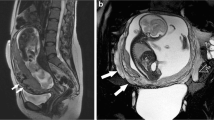Abstract
Retained placenta accreta can cause catastrophic postpartum hemorrhage. This study aims to determine whether MR imaging can differentiate retained placenta accreta from postpartum hemorrhage caused by other conditions. Fourteen cases suspicious for retained placenta were examined with MR imaging. Signal intensity, the enhancing pattern of uterine contents, and flow voids within the myometrium were retrospectively studied. As hysterectomy was performed in only two cases, final diagnosis was based on clinical outcome and analysis of uterine contents. Final diagnoses were retained placenta accreta in seven cases, retained normally attached placenta in four, hematoma in two, and placental site trophoblastic tumor (PSTT) in one. All seven cases with placenta accreta had a very hyperintense area on T2-weighted images, showing transient early enhancement. None demonstrated delayed strong enhancement around the hyperintense area. In two cases with retained normally attached placenta and in both with hematomas, there were no hyperintense areas on T2-weighted images. Of these, only one showed transient early enhancement. Flow voids were observed in four cases with placenta accreta, one with normally attached placenta, and the case with PSTT. A markedly hyperintense area on T2-weighted images and transient early enhancement without delayed strong enhancement between the mass and the myometrium can indicate retained placenta accreta.





Similar content being viewed by others
References
Cunningham FG, MacDonald PC, Gant NF, Leveno KJ, Gilstrap LC III, Hankins GDV, Clark SL (1997) Disease and abnormality of the placenta. In: Williams Obstetrics, 20th edn. Appleton and Lange, Norwalk
Tanaka YO, Sohda S, Shigemitsu S, Niitsu M, Itai Y (2001) High temporal resolution dynamic contrast MRI in a high risk group for placenta accreta. Magn Reson Imaging 19:635–642
Levine D, Hulka CA, Ludmir J, Li W, Edelman RR (1997) Placenta accreta: evaluation with color Doppler US, power Doppler US, and MR imaging. Radiology 205:773–776
Kim H, Hill MC, Winick AB, Shen T (1998) Residents’ teaching files. Prenatal diagnosis of placenta accreta with pathologic correlation. Radiographics 18:237–242
Ha TP, Li KC (1998) Placenta accreta: MRI antenatal diagnosis and surgical correlation. J Magn Reson Imaging 8:748–750
Marcos HB, Semelka RC, Worawattanakul S (1997) Normal placenta: gadolinium-enhanced dynamic MR imaging. Radiology 205:493–496
Entel RJ, Kane JA, Weiss BR (1998) Postpartum magnetic resonance imaging in a case of placenta accreta with intrauterine abscess formation. Arch Gynecol Obstet 262:91–94
Miyata M, Yoshioka K, Ehara S, Tamakawa Y, Sato T, Kagabu T (1998) MR findings of placenta accreta: a report of four cases. Jpn J Magn Reson Med 18:440–445
Amoh Y, Watanabe Y, Saga T, Dohke M, Sato N, Mitsudo K, Nakahori T, Ukita M (1995) Retained placenta accreta: MRI and pathologic correlation. J Comput Assist Tomogr 19:827–829
Neish AS, Frates MC, Tempany CM (1995) Placenta percreta post evacuation: an unusual uterine mass on MRI. J Comput Assist Tomogr 19:824–827
Noonan JB, Coakley FV, Qayyum A, Yeh BM, Wu L, Chen LM (2003) MR imaging of retained products of conception. Am J Roentgenol 181:435–439
Preidler KW, Luschin G, Tamussino K, Szolar DM, Stiskal M, Ebner F (1996) Magnetic resonance imaging in patients with gestational trophoblastic disease. Invest Radiol 31:492–496
Huang MW, Muradali D, Thurston WA, Burns PN, Wilson SR (1998) Uterine arteriovenous malformations: gray-scale and Doppler US features with MR imaging correlation. Radiology 206:115–123
Kido A, Togashi K, Koyama T, Ito H, Tatsumi K, Fujii S, Konishi J (2003) Retained products of conception masquerading as acquired arteriovenous malformation. J Comput Assist Tomogr 27:88–92
Brandt KR, Coakley KJ (1998) MR appearance of placental site trophoblastic tumor: a report of three cases. Am J Roentgenol 170:485–487
Silverberg SG, Kurman RJ (1992) Tumors of uterine corpus and gestational trophoblastic disease. Armed Forces Institute of Pathology, Washington DC
Author information
Authors and Affiliations
Corresponding author
Rights and permissions
About this article
Cite this article
Tanaka, Y.O., Shigemitsu, S., Ichikawa, Y. et al. Postpartum MR diagnosis of retained placenta accreta. Eur Radiol 14, 945–952 (2004). https://doi.org/10.1007/s00330-004-2266-8
Received:
Revised:
Accepted:
Published:
Issue Date:
DOI: https://doi.org/10.1007/s00330-004-2266-8




